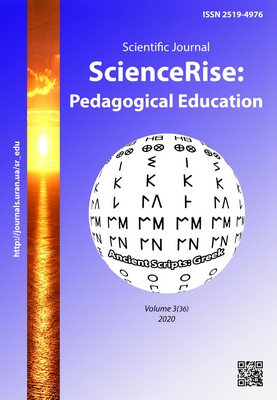Дискусійні питання щодо ролі лекції в процесі викладання дисципліни «Пропедевтика педіатрії» в умовах сучасної медичної освіти
DOI:
https://doi.org/10.15587/2519-4984.2020.203243Ключові слова:
лекція, анонімне анкетування, студенти, медична освіта, навчальний процес, пропедевтика педіатріїАнотація
Важливою задачею сучасної вищої школи України є всебічне вдосконалення навчального процесу на основі кращих досягнень світової та вітчизняної дидактики. Серед великого переліку форм і методів навчання у закладі вищої освіти лекція завжди посідала чільне місце. Проте на сьогоднішній день в умовах реформування вищої освіти питання про доцільність лекції, як невід’ємної частини навчального процесу, активно дискутується. Метою дослідження було визначення значимості і роль лекції в процесі викладання дисципліни «Пропедевтика педіатрії» в умовах сучасної медичної освіти. Проведено анонімне анкетування 593 студентів третього курсу Дніпропетровської медичної академії, серед яких: 377 респондентів – вітчизняні студенти, 170 – іноземні англомовні студенти та 46 – іноземні російськомовні студенти. Як показали результати, для більшості вітчизняних та іноземних студентів третього курсу лекція є обов’язковою формою навчання, а лекції з «Пропедевтики педіатрії» є досить інформативними та необхідними. Крім того, студенти досить високо оцінили роботу професорсько-викладацького колективу з розробки лекцій та рівень подачі лекційного матеріалу на кафедрі пропедевтики дитячих хвороб. Найчастішими пропозиціями як вітчизняних, так й іноземних студентів, щодо підвищення ефективності лекцій виявилися: збільшити кількості лекцій та навчальної інформації в них; наводити більшу кількість клінічних прикладів з власного досвіду практичного лікаря; збільшити кількість відеоматеріалів під час лекційного заняття. Отже, лекція в сучасних умовах вітчизняної вищої медичної освіти повинна залишатися провідною та необхідною формою організації навчального процесу. Для підвищення ефективності лекційного матеріалу викладачам необхідно враховувати індивідуальні особливості та потреби студентів
Посилання
- Vlasenko, O. V., Drachuk, O. P. (2017). Pidhotovka kadriv na tretomu rivni vyshchoi osvity v suchasnykh umovakh yii reformuvannia. Pidhotovka medychnykh kadriv u suchasnykh umovakh reformy systemy okhorony zdorovia Ukrainy. Vinnytsia, 33–35.
- Romanyuk, L., Kravets, N. (2018). A structured approach to the teaching of microbiology, virology and immunology for medical students. ScienceRise: Pedagogical Education, 6 (26), 30–33. doi: http://doi.org/10.15587/2519-4984.2018.140910
- On Higher Education (with changes and additions) (2014). Law of Ukraine No. 1556-VII. 01.07.2014. Available at: https://zakon.rada.gov.ua/laws/show/1556-18?lang=en
- Ilchenko, S., Yaroshevskaya, T., Skryabina, E., Kramarenko, N. (2018). Analysis of the level of knowledge of pediatric propaedeutics, taught in junior courses among young doctors. ScienceRise: Pedagogical Education, 7 (27), 28–32. doi: http://doi.org/10.15587/2519-4984.2018.153376
- Zamorskyi, I. I., Khmara, T. V. (2016). Znachennia lektsii yak vahomoho piznavalno-vykhovuiuchoho faktora u pidhotovtsi maibutnoho medychnoho pratsivnyka. Medychna osvita, 1, 70–73.
- Zhurakivska, O. Ya. (2015). Rol lektsii pry vykladanni teoretychnykh dystsyplin v systemi bolonskoi osvity. Svit medytsyny ta biolohii, 1 (48), 199–200.
- Filippova, L. V. (2011). Problemy chytannia lektsiinoho materialu u vyshchykh navchalnykh medychnykh zakladakh. Pedahohichna osvita: teoriia i praktyka, 7, 103–107.
- Kyryan, T. I. (2018). The development of lecture form in educational process in the higher medical education of Ukraine (the end of the XX – the beginning of the XXI century). Scientific journal of M .P. Dragomanov National Pedagogical University, 62, 89–92.
- Machynska, N. I., Stelmakh, S. S. (2012). Suchasni formy orhanizatsii navchalnoho protsesu u vyshchii shkoli. Lviv: Lvivskyi derzhavnyi universytet vnutrishnikh sprav, 180.
- Hai, L. A., Sukhіn, Yu. V., Wenher, V. F., Muksen Saied, Serdyuk, V. V. (2016). Modern methods of teaching of mediсal disciplines in higher education. Medychna osvita, 1, 15–18.
- Kaidalova, L. H. (2012). Teoretyko-metodychni aspekty vykladannia lektsii u vyshchomu navchalnomu zakladi. Novi tekhnolohii navchannia, 72, 96–100.
- Kulbashna, Y., Tkachuk, E., Zakharova, V. (2018). New tasks and functions of the teacher of innovative type in the preparation of the competent doctor. Educological Discourse, 1-2 (20-21), 141–157. doi: http://doi.org/10.28925/2312-5829.2018.1-2.31220
- Tolochko, S. V. (2018). Modernization of methodological teachers competence in the system of postgraduate education for the future. Visnyk Natsionalnoho universytetu "Chernihivskyi kolehium" im. T.H. Shevchenka, 151 (2), 73–78.
- Roberts, D. H., Newman, L. R., Schwartzstein, R. M. (2012). Twelve tips for facilitating Millennials’ learning. Medical Teacher, 34 (4), 274–278. doi: http://doi.org/10.3109/0142159x.2011.613498
- Joyner, B. D. (2016). How to Effectively Teach Millennials: Understanding Intergenerational Factors. Handbook of Clinical Teaching, 39–48. doi: http://doi.org/10.1007/978-3-319-33193-5_5
- Iaremenko, O. B., Fedkov, D. L., Dobrianskyi, D. V., Dudka, P. F., Ilnytskyi, R. I., Tarchenko, I. P., Meliksetyan, A. V. (2018). Changing the format of lecture classes for new generation medical students. Medical Education, 4, 117–120. doi: http://doi.org/10.11603/me.2414-5998.2018.4.8850
- Amosova, K. M. (2018). Khto taki "milenialy", i yak navchaty takykh studentiv. Available at: https://life.pravda.com.ua/columns/2018/01/16/228473/ Last accessed: 10.04.2020
##submission.downloads##
Опубліковано
Як цитувати
Номер
Розділ
Ліцензія
Авторське право (c) 2020 Naira Mishina, Svitlana Ilchenko, Anastasiia Fialkovska

Ця робота ліцензується відповідно до Creative Commons Attribution 4.0 International License.
Наше видання використовує положення про авторські права Creative Commons CC BY для журналів відкритого доступу.
Автори, які публікуються у цьому журналі, погоджуються з наступними умовами:
1. Автори залишають за собою право на авторство своєї роботи та передають журналу право першої публікації цієї роботи на умовах ліцензії Creative Commons CC BY, котра дозволяє іншим особам вільно розповсюджувати опубліковану роботу з обов'язковим посиланням на авторів оригінальної роботи та першу публікацію роботи у цьому журналі.
2. Автори мають право укладати самостійні додаткові угоди щодо неексклюзивного розповсюдження роботи у тому вигляді, в якому вона була опублікована цим журналом (наприклад, розміщувати роботу в електронному сховищі установи або публікувати у складі монографії), за умови збереження посилання на першу публікацію роботи у цьому журналі.









